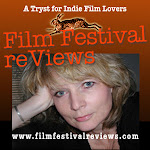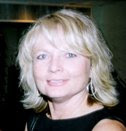On Thursday, April 2, the New York Women in Film & Television (NYWiFT) panel Getting the Most Out of a Film Festival - A Guide for Filmmakers started promptly at 6:30 p.m. and I was still on the NJ Transit bus dragging its way up the snaking , snorting conga line into Port Authority. It was a learning experience, as I was one of the panelists, cursing under my breath about the Thursday night rush hour into the City, running down the street against the flow of pedestrian traffic towards One Penn Plaza. Fortunately, the evening was just kicking off with introductions as I joined my esteemed fellow panelists.
Ted Hope, producer of nearly sixty notable films including three Sundance Grand Prize winners and the recently released ADVENTURELAND was the modertor. He took my entrance in stride allowing me to momentarily catch my breath before including me in the discussion of how to festival your film at film festivals. The discussion began with what festivals are the best to get into and should the filmmaker expend time, energy and funds to get into the Top Five (Cannes, Berlin, Sundance, Toronto, Venice) Ryan Werner, IFC Films and Winnie Lau, Fortissimo Films, coming from the film acquisition end, responded with their experiences for finding and distributing films within the circle of the top five where some include an international film market.
How to approach producers, filmmaker etiquette was a discussion thread that cautioned excessively assertive behavior having a negative backlash especially when interrupting a business conversation. On the other hand, that same persistence could gain attention for the film if memorable loglines eventually make an impression on the intended person. The junior executives may be a better way to approach rather than going after the top executive whose time is usually scheduled-to-the-max for their entire film festival stay. Finding a champion for the film among the assistants is one of the most effective ways of getting the film watched by high level executive decision-makers.
Anne Chaisson, producer and co-chair of the Advisory Board at the Hamptons International Film Festival, helped the audience understand the difference between the Publicist and Producer's Rep, two positions that assist filmmakers promote their films. A publicist has media contacts and finds people like me to watch the films and write about them. A Producer's Rep arranges meetings with buyers, distributors, other film festival representatives and, as Lau cautioned, should never take a fee upfront. Their fee is based on the agreed amount after a sale is made and not before. She also explained a Sales Agent's role which as I would expect it to be, a person who actually makes the sales agreement with the "brass ring" - the distribution deal.
The discussion then veered from feature films to documentaries. Hope turned to me and asked my opinion on the best way to submit a film and what are the top documentary film festivals. Withour a doubt, Without-A-Box offers filmmakers a way to submit their film to hundreds of film festivals for one flat fee. Established in 2002, WAB is a highly-regarded company for indie film submissions with an astronomical number of filmmaker and film festival membership. Last year, IMDb (Internet Movie Database), the biggest online film information site acquired WAB, so filmmakers can now get their filmmaker information and credits on the IMDb. This, in turn, is under the huge Amazon umbrells, a place where the public can then buy independent film DVDs.
As for the documentary film festivals, I still see the Top Five as being Cannes, Sundance, Berlin, Toronto, Rotterdam. SxSW is increasingly stronger with its docs followed by music week. Hot Docs (Toronto) and SILVERDOCS (Silver Spring, MD the DC metro area) have solid programming, great audiences, surrounded by international communities, offering conferences and pitch sessions. Slamdance coincides with Sundance and its laid back, yet indie supporting focus, finds and shows the gems worth discovering. Other good festivals include Full Frame (Durham, NC); True/False, (Columbia, MO); Edinburgh International Film Festival, Sheffield Doc Fest have solid reputations and loyal programmer followers from other film festivals. One festival I suggest and will keep my eye on is Big Sky Documentary Film festival in Missoula, Montana. Sandwiched between Sundance and Berlin festival schedules, I took the trip out west two years ago and found it to be a great place for filmmakers. The community is film savvy - one local told me he sees films at the renovated Wilma Theatre (a magnificent former vaudeville theater) and rents documentary films as soon as the video rental store gets them in. I met Les Blank and in our podcast conversation, he discussed ways to position yourself and had strong opinions on a film's premiere and how and when it should be given up.
Film festivals are my passion as are independent features and other non fiction films I discover during my travels whether its across the country or across the ocean (or the pond), While festivals are a platform for film and filmmakers to spingboard off of, they are a business, a complex forum of film programming, world premieres, celebrity highlights, cinematic retrospectives, themes and sidebars and the economic balance of tourism, partnerships and sponsorships. Supporting the films and cinematic media provides independent film lovers an alternative to the mainstream studio fare. Keep making those films. Keep the faith.

